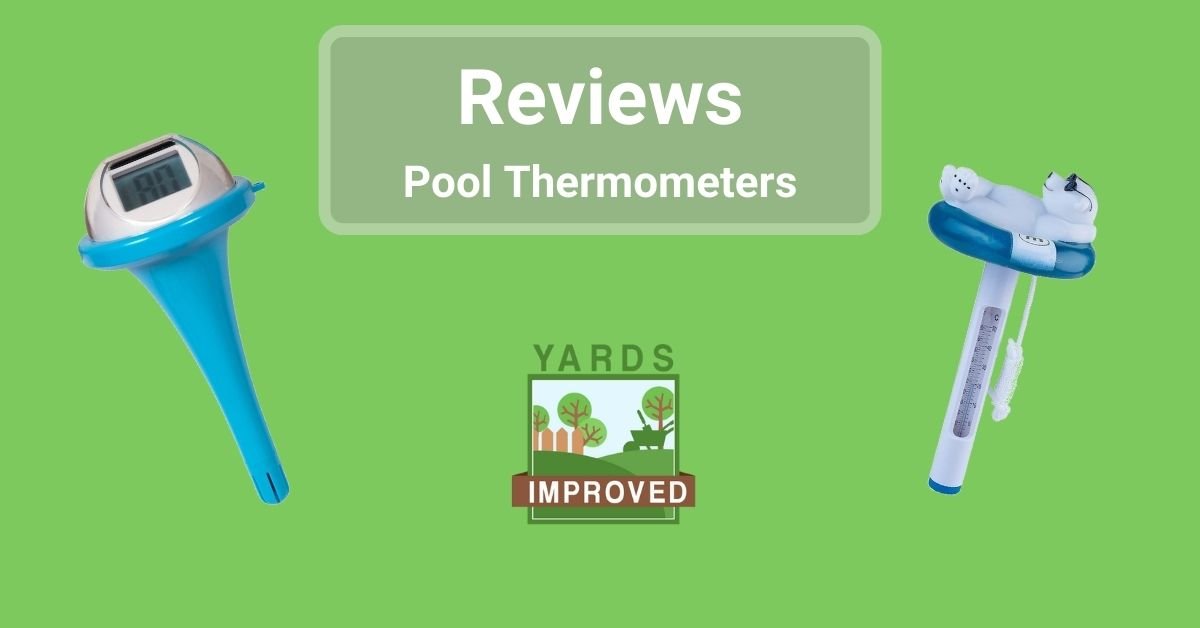Are you like Goldilocks when it comes to jumping in the swimming pool? Do you have to dip your toe to be sure the water’s not too hot, not too cold, but just right? Then have we got the review article for you – and it will let you decide without taking off your shoe!
A pool thermometer does more than just let you know if the water’s right for you. Too hot or too cold can be both a symptom and a cause of other problems. It’s always good to get a quick look at the water temperature. If needed, you can make any necessary adjustments.
Personal Comfort
We do think personal comfort in the pool should be the principal consideration for a swimming pool, though. With total respect for those who love the Polar Bear Plunge or those who want to do laps in a hot tub, most people like their pool water between about 77° and 82° Fahrenheit (25° to 28° C). Olympic swimming pools are kept in this range, too. Lower than 70° feels chilly. Over 83° can make us start sweating.
Of course, not everyone can heat or chill their pool. So it’s good to be aware of the temperature before diving in.
Water Quality
But it’s not just your comfort level to think about when water gets too hot or too cold.
Short-term temperature changes are not a big deal. But prolonged high temperatures (over 90°) can accelerate the breakdown of chlorine, lead to scaling on the pool’s surfaces, and provoke algae growth. If you notice the pool temperature has been in the mid-80s or above, it’s a good idea to test the water!
Cold temperatures don’t have as drastic an effect – unless they reach the freezing point. Then, water can expand, damaging the walls of the pool. It’s always a good idea to prepare your pool for the cold season well ahead of time!
Types and Features of Pool Thermometers
Of course, it’s hard to obtain an accurate water temperature by touch. You need a good thermometer to do the job!
Accuracy
Of course, you want your thermometer to give an accurate reading of the water temperature. It should measure the temperature – but it should also take the right temperature. The design of the pool thermometer should help it take the “below the surface” temperature of the water. It shouldn’t be overly influenced by sitting in the sun or shade.
Durability
We see it about almost everything, of course. Be sure to get a thermometer that’s going to hold up. It has to withstand exposure to the elements – including being in the water all day, every day. But it also has to stand up to hitting the side of the pool or being bumped by swimmers.
Floating vs. Hanging
Some pool thermometers float freely around the pool. Others attach to a pool wall or the ladder.
The hanging version is going to give you a better reading. It’s completely submerged, so it only measures the water temperature. A floating thermometer may seem more convenient, but its exposure to the air means its reading won’t be accurate.
There are also handheld infrared scanners that have a high level of accuracy. You only need to point them at the water and pull the trigger. We haven’t reviewed any of those here, though; we feel they’re best suited for competition-grade pools.
Digital vs. Analog
Of course, you need to be able to read the temperature on the thermometer! For this, you have your choice between old-fashioned glass mercury thermometers and newer, digital versions.
If you’ve ever tried to read a glass thermometer, you know how tough it can be.
Digital thermometers are easier and quicker to read. Some require batteries, but others are solar-powered. And some of them offer . . .
WiFi and Bluetooth
Yes, you may not even have to get near the water to check your pool’s temperature. Many can send a signal to your phone or computer via WiFi or Bluetooth. This makes it more convenient for you to keep track of the temperature.
Reviews of the Best Pool Thermometers
We’ve dipped our toes into the pool thermometer market, and have a few to recommend to you! We’ve focused mainly on digital versions because of their convenience and accuracy. But a couple of analog versions are worth considering, too.
Digital
Ambient Weather Wireless 8-Channel Floating Pool Thermometer
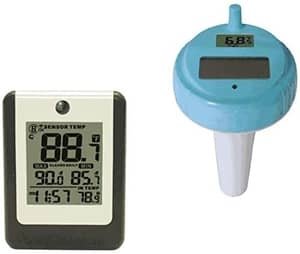

Our top pick comes with a wide array of features. It even offers the ability to connect up to 8 sensors and receivers. We can’t imagine that being a feature that homeowners will need, of course.
This set contains a floating thermometer sensor and a receiver that you can attach anywhere within 100 feet. That means you could read your water temperature – right from your back door!
Both the sensor and the receiver have digital LCD readouts.
This unit does require 4 “AAA” batteries.
You get an accurate reading and a lot of convenience with this unit.
On the other hand, it does come with a higher price tag than other pool thermometers we’ve looked at. Also, it is a floating unit. The sensor is far enough underwater, though, that it should give a good reading.
The other drawback is that you need a clear line of sight for the connection between the receiver and sensor to work. Oddly, even a small obstacle – like the edge of the pool – can break the connection. If it’s on the other side of the pool, giving a clear line, it will work fine.
Overall, we rate this unit high for functionality. If you don’t mind the price tag, it’s a good unit to have.
GAME Solar Digital Pool & Spa Thermometer
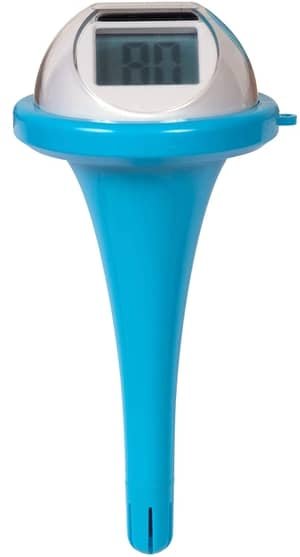

This model comes in at a better price and gives an accurate reading. But it doesn’t have the wireless capabilities of the model listed above. However, it is solar-powered – which will save you even more money in the long term!
The device floats freely in your pool. The sensor will be 5 inches below the water’s surface, which gives a reasonable measure of the temperature throughout the swimming pool (not just at the surface).
It has a large digital display that’s easy to read. It does include a line so you can attach it to the side of the pool, so it won’t float so far away that you can’t see the display.
You can choose Fahrenheit or Celsius for the readout.
The solar cell absorbs enough energy to keep it running consistently.
We have seen a lot of reports that moisture gets into the display over time, making it “foggy” and impossible to read. Unfortunately, this seems to happen in a lot of cases after only a few months.
Inkbird Wireless Pool Thermometer
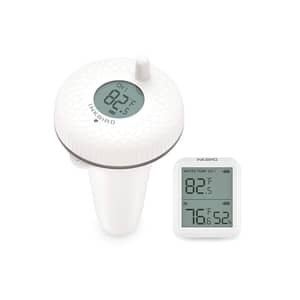

Read your pool’s temperature remotely with this thermometer from 100 feet away! Sure, like similar models, the range is listed as higher, but we’ve never found the higher limit to be reliable. Still, 100 feet is more than enough for most situations!
The unit runs on batteries and provides an easy-to-read LCD readout on the remote receiver and the sensor itself. The receiver also measures area temperature and humidity.
The sensor floats in your pool and measures the temperature at about 5 inches below the surface. It does have a hole where you can attach a rope to tie it to your ladder or the side of the pool.
It’s easy to switch from Fahrenheit to Celsius and to switch channels for better reception.
It seems that over time, the temperature begins to read higher than it should. But a simple reset usually fixes this (remove and replace the batteries, restart it while pushing a button). It’s a minor annoyance but easily corrected.
Analog
Aquatix Pro Premium Water Temperature Thermometer
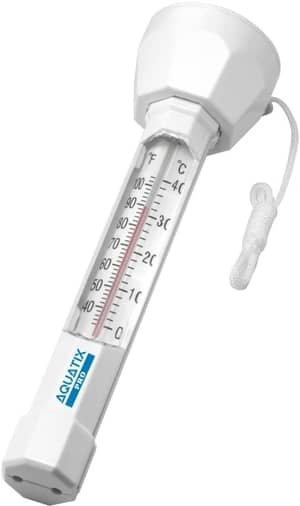

A solid plastic unit encases this thermometer, protecting it while still making it easy to read.
Of course, reading this type of thermometer is a bit tougher than a digital readout. But the large numbers and score marks, along with the overall design, make it as easy as possible.
There is a tether line attached to the top so that it won’t float too far away. However, you do have to pull the unit out of the water to read it.
It’s a durable thermometer that gives an accurate reading. It should hold up longer than digital versions. The only drawback is having to grab ahold of it to read it.
Milliard Floating Pool Thermometer
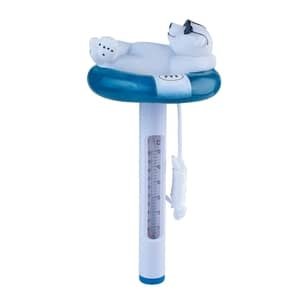

If you’re looking to relax in the pool, you’re not the only one. It’s a decent analog thermometer, but it’s most notable for the polar bear with sunglasses that adorns the top. It looks fantastic as it disguises that this is a thermometer.
The tube that extends below the water provides an ok view of the thermometer itself. It’s not too difficult to read, although it would be nice if the opening were a tiny bit wider and the gradations larger.
It includes a line to anchor it in place.
It’s a cute piece and a great conversation start; it looks like a pool toy rather than a tool. And it gets the job done, as long as you don’t mind getting a little wet to read it.
Conclusion
If you want to feel refreshed after a dip in the pool and keep the pool water healthy, the water should stay in the appropriate temperature range. And to check that, you need a quality pool thermometer. Digital versions that can notify you on your phone are the modern way to go. But traditional glass thermometers are still available, as well. Our reviews should help you pick the best one – so enjoy that cool, relaxing swim!

